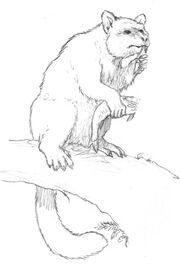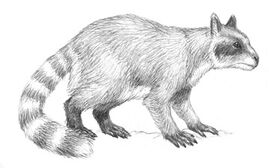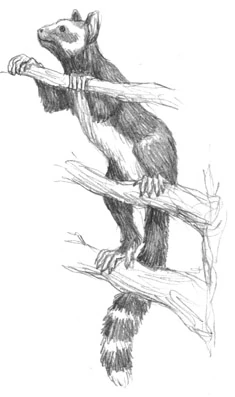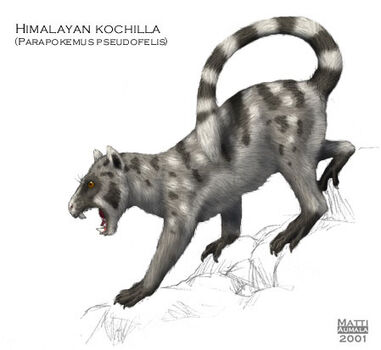INTRODUCTION[]
Pokemuroids represent another group of Spec mammals that are almost, but not quite, the familiar mammals of Home-Earth. While these furry little tree-climbers are technically primates, they differ significantly from RL's apes and monkeys, although they are related to the lemurs (albeit distantly) as adapids.
HISTORY[]
Studying the fossil record, it has become clear the the formal clade Adapidae is, in fact, paraphyletic, incorporating a range of unrelated groups. Although using the term 'adapids' (with a small a) is permissible as a reference to all lemurs, lorises, pokemuroids, and related forms, formal Adapidae is not a very useful term, taxonomically. This is because 'adapids' are split into two distinct groups, not particularly related. One includes the lorises and lemurs of both Spec and Home-Earth, while the other (being only in Spec's timeline) produced the pokemuroids.
Pokemuroids have lived in Asia since the Eocene, when they emerged from a complex of related forms, many similar to Plesiadapsis, an early primate of our own timeline. The pokemuroids seem to have passed relatively unscathed through the catastrophe at the end-Eocene, and quickly spread to Europe and North America, taking control of the majority of the arboreal niches in the Northern Hemisphere.
Like other primates, pokemuroids possess forward-facing eyes for binocular vision, opposable thumbs on hands and feet, nails rather than claws, a post-orbital bar (a bone that creates the eye socket), and vertical incisors. However, the foramen magnum, the large hole in the skull to which the spinal chord is attached, does not project downward from the skull as in other primates, but straight back, as in most other mammals. Thus, pokemuroids can not stand as lemurs (and humans) do, spine perpendicular to the ground, head angled forward. Instead, pokemuroids hold themselves like cats or dogs, with the spine parallel to the ground, with the head part of the same axis. In the 3-dimensional environment of the trees, this fact makes little difference, but the orientation of the foramen magnum means that on the ground, pokemuroids scamper on all fours, they do not hop on their hind legs like many other primates.
POKEMURIDAE (Pokemuses)[]
Pokemuridae encompasses the greatest pokemuroid diversity, with species across Eurasia and Africa. These creatures range in size from a minuscule 90 grams to a relatively hefty 3 kilograms, and in behavior across the spectrum of omnivory from fruit-eater to ferocious carnivore. True pokemurids are distinguished from their relatives mostly in their dentition. The teeth of a pokemurid are quite odd, with large, grinding molars, tiny canines (even in carnivorous species) and large, gnawing incisors. The arrangement is similar to that of the aye-aye (Daubentonia madagascarensis), an RL lemur, though this fact is due to convergence, rather than any close affinity between the two groups. Most pokemus species use their incisors to pierce the armor of insects, but some gnaw fruits and nuts in the manner of xenotheridians (or Home-Earth rodents). In the carnivorous species, the upper incisors grow into a sharp pick with which they dispatch their prey.
In Spec's fossil record, pokemurids first turn up in the Miocene, though they probably evolved sooner, and spread to take over the niches of the other pokemus-like primates of the time. They lived in Asia and North America, and soon moved into Europe and Africa, where they quickly established themselves in most of the same forms we see today. The only major perturbation in pokemurid evolution occurred at the end of the Pliocene, when the encroaching Last Ice Age killed pushed all Eurasian pokemusids into India and the Middle East. North America was hit even harder, and as South America was already home to a variety of tree-climbing marsupials and lorises, pokemuses could not migrate south and today are completely died out in the New World. Today, a single pokemus species, Macropokemus americensis, makes its home in North America, the result of a Pleistocene migration across Beringia.
Lion-Tailed Pokemus (Pokemus pokemus)[]
The lion-tailed pokemus is an arboreal, omnivore that lives in southern Europe and the Middle East. The first pokemus species to be named, this little animal is similar to the lemurs of Madagascar, but of a different lineage entirely.
The diet of the lion-tailed pokemus consists mostly of insects and smaller vertebrates, which it stalks, catlike, from hidden branches. Pouncing with lightning speed, this little pokemus snatches the avialan or lizard with its nimble, humanlike hands. Retaining a firm grip on its branch with a similarly dexterous pair of feet, the lion-tail quickly kills its prey with a sharp bite to the base of the skull before it begins to feed.
Lion-tailed pokemuses are monogamous, mature males and females forming hunting pairs that stay together for life. Young lion-tails remain with their parents for two years, learning to hunt before they set off to find mates of their own.
Common Pokemus (Pokemus vulgaris)[]
The common pokemus is a ubiquitous fixture of the forests of eastern Asia. This close relative of the lion-tailed pokemus is even more omnivorous than its western cousin, feeding upon smaller vertebrates, all manner of invertebrates, carrion, and even the young shoots of bamboo plants.
Common pokemuses are the principal prey of packs of moulong, which pursue the little primates through the forest in shrieking mobs. Usually, the pokemuses' only recourse is to run, but when cornered, lash out with ripping hands and sharp incisors.
Sivachilla (Viverramimus striatus)[]
The sivachilla is a nocturnal pokemurid that seems to represent the type of pokemurids that later split into felimurids and macropokemurids. The sivachilla is not a true macropokemurid but a completely separate taxon. These predator/omnivores are found in the forests of Southern Asia. Sivachillas will sleep most of the day up in the trees but at dusk it will climb down to look for food on the ground. Like macropokemurids, sivachillas have a varied diet; while insects, lizards, smaller mammals and bird eggs and young are their main source of nutrition, they are also known to eat certain fruits and nuts.
Latura (Oiboedestes tiphus)[]
The latura is a screaming horror of the more open areas of South East Asia. When the dinosaurian arbros go to sleep at night, the latura takes over the night shift. They terrorize nocturnal dinosaurs and mammals; even following them home to chomp up nestlings and babies for consumption. Laturas are experts at the art of patient ambush. They will wait on a choice branch overlooking small game trails for hours or even several nights before pouncing on a wandering critter.
Laturas have a tight polyamorous reproductive system. there is no real hierarchal structure in the species except for territorials and wanderers. Wanderers of either sex have never been observed mating or breeding. They court either other wanderers or establish territorials; then set up home ranges if successful.
Territorials are sexpots, both sexes enthusiastically enjoy bisexual relations with their chosen mates. Each female whelps between 2 to 4 young every year in a communal nest with all members of the territory fiercely guarding them. The latura babies take nearly six months to wean and often remain for years, helping their parents, biological and adoptive; to raise the next litters.
The latura is a vertebrate killer. They prey on frogs, lizards as well as mammals and dinosaurs up to 20 kilos. An old male latura was frequently observed killing small jackalopes and juvenile ceratopsians. The heavy set jaw, serrated teeth and long claw like nails easily pierce flesh. The latura method of killing is rather cat-like, with a quick savage bite to the vertebrate, severing the spinal cord. This savage killing streak belays their rather small size at just 5 kilos.
These brindled bluish black mammals also have an intensive rivalry with ninjas. Adult ninjas frequently kill juvenile laturas. Indeed, up to 60% of latura youngsters have been destroyed by marauding ninjas during some years observed. However, no ninja has ever been witnessed killing an adult latura. But the reverse has been seen several times in wild camera traps, personal experiences and once in captivity.
Recently, a live ninja was trapped for the first time and brought into a base camp in Thailand. The spexplorers set it at the opposite end of the camp, between their tents, other specimens and the single captured female latura. The next morning, they awoke to see that the latura had escaped from her cage. The wary scientists looked around with tranq guns and nets, but couldn't see any sign of her among the usual suspected areas, the tents were fine, the other collected live specimens that might be considered prey were unruffled; nothing was missing from the dissection tables. They chalked it up to a resourceful critter who escaped back into the jungle.
The camp was broken down for a trek back to base when the latura was discovered in the ninja cage. The true power of the latura was finally understood. The 4 kilo female had ripped her way out of her cage, headed straight to the terrified ninja; torn open his cage and crushed his neck. There was no evidence of the latura consuming her kill, she had simply obliterated the life of this predatory dinosaur nearly ten time her weight.
Understandably, laturas are treated with great respect, yet they are strangely docile around humans, even allowing themselves to be manhandled with little complaints. Laturas are even known to follow humans through their territories, chasing off deadly predators and roosting nearby during the day.
MACROPOKEMURIDAE (Chillas)[]
Chilas are a fairly recent evolutionary development, which probably evolved during the Pliocene, no more than ten million years ago, and spread across eastern Asia and western North America via the land bridge of Beringia. Chillas are more terrestrial in their habits than the their close cousins, the pokemurids, and although they remain adept climbers, they can also run quickly across ground and swim with ease.
Raichilla (Macropokemus sinensis)[]
Raichillas are large (6 kg), heavily-built chillas, derived from arboreal stock, but fully at home on the ground, or even in the water. Chillas tend to be more carnivorous than pokemuses, and often dine on fish or carrion.
Pikachilla (Macropokemus nipponicus)[]

Pikachilla, Macropokemus nipponicus with Brown Japanese pseudovole, Pseudarvicola orientalis (Japan: Hokkaido to Kyushu)
The island chain of Japan was only recently separated from the Chinese mainland, and so most Japanese plants and animals are little changed from their mainland ancestors. The pikachilla is a case in point, a species endemic to the Japanese islands, but part of genus that extends across eastern Eurasia and North America.
Like other chillas, the pikachilla is a raccoon-like omnivore with heavy tendencies toward carnivory. Pikachillas are stalkers, pouncing from a hiding place to grab an unwary bird or smaller mammal. These intelligent creatures often cooperate to bring down larger game, and have been known to take down young kirin. Usually, though, they are content with smaller game.
Not-a-coon (Macropokemus americensis)[]
Not-a-coons certainly resemble the HE racoon, but they are Chilas . They have very similar dietary habits, though with much more social families. Like most pokemures, not-a-coon males and females pair up for life, often within a larger tribe of extended relatives all defending a shared territory. The mated pair reproduce in midwinter and the female births 1 to 4 babies in early summer. The precocial offspring join the parents and eventually the larger family on foraging outings within weeks. Spexplorers occasionally wake up to see one large masked face with one or more smaller faces tightly clinging the parent as they rummage through backpacks.
The range of the not-a-coon is vast, incorporating virtually all the deciduous forests east of the western North American mountain chain. Two closely related species occur along the Pacific coast in a disjunctive spread from Alaska to the central Mexican valleys, meeting near the Baja Peninsula.
FELIMURIDAE (Tree foxes)[]
More predatory than the other two pokemurid families, felimurids have re-evolved sharp canines, which they use, in conjunction with an array of slashing carnassial teeth, to kill their prey. The nails on the hands and feet are curved and sharp (though technically not claws), and in some species, the toes on the hind limbs have lost their opposability.
The arboreal felimuses fill the niches of such RL carnivores as cats and martens. These predators can be found in Eurasia and in Africa, where deep forests exist to support their lifestyle. In the mountains of Europe and Asia, 'tree foxes' may grow to large size, and occupy the niche of large scavenger/predator, but due to competition from draks and other mammals like the metacanids, Felimuridae has never produced a fully terrestrial predator.
Red Felimus (Felimus flexilis)[]
The red felimus, or red tree fox, is common in central Europe, and its relatives are found in different parts of northern Eurasia. The Red felimus's main prey are birds and smaller mammals, but reptiles, amphibians, bird and non-avian dinosaur eggs and young, and even mushrooms and fish may end up in on the primate's menu.
Khuffa (Afrofelimus somethingorotheri)[]
The khuffa is a civet-like felimurid from Africa.
Himalayan Kochilla (Parapokemus pseduofelis)[]
Kochillas (genus Parapokemus) are highly specialized felimurids', a primate's answer to the metatherian possum-hounds. With their nimble hands and feet and flexible spines, kochillas out-compete their counterparts in rocky habitats, although they cannot run as fast across level ground. Kochillas' faces are elongated and dog-like, the eyes small and the nose large. Their hands still retain opposable thumbs, but these digits have been lost in the feet, which are now paws for running.
The Himalayan kochilla is a relatively large (15kg) generalist predator of the rocky, alpine reaches. Kochillas are excellent stalkers, hunting by stealth like their arboreal ancestors. It seems that its climbing abilities have given the kochilla an advantage over the bipedal theropods in the mountains of the Himalaya, and thus it has become one of the world's largest terrestrial mammalian predators.
Eurasian Ilve (Felipithecus sinisalonis)[]
The ilves represent two species, the Eurasian ilve (Felipithecus sinisalonis) and the North American Agropelter F. canadiensis. They are quite large felimurids at some 6 to 10 kilos. Their most interesting aspect seems to be their ability to live in the cold boreal zone of the holarctic. Except for the common pokemus and the kochillas, no other pokemurideans live this far north. Diet-wise, they are more omnivorous than any other felimure, nearly 40% of their food intake may consist of plants at times.
Studying the marked territories and movements of ilves proved that they seemed to move outside their territories quite often, usually when the owner of the neighboring territory was also away. Such behavior had previously been observed in HE housecats but not before in pokemurideans. The animals seemed to also leave "no man's land" areas between their territories, possibly in prey-poor areas, where all observed meetings were peaceful, and where females often came in spring to leave marks of their readiness to mate instead of leaving these markings on the borders of their own territories. It seemed that the females preferred to draw in all the prospective mates to one neutral place, possibly to protect their own last years litters, which often followed their mothers to the point of her next pregnancy. After being observed in ilves, similar behavior was also seen in tree foxes, although the neutral areas and the associated behavior of the females in heat seemed to be unique to the ilve.
Ilves had been known to visit carcasses not being guarded by larger carnivores, but this was considered to be highly opportunistic, random behavior. However to the great surprise of the scientists, they once observed seven satellite tracked individuals on the same carcass. To better observe such behavior, the scientist set up a new carcass with hidden cameras in hopes of better observing the behavior of the ilves on such a situation. After some initial failures, the plan finally succeeded, and for the first time felimurid animals were seen not only feeding in the same place in relative peace, but also exhibiting signs of some kind of hierarchy among the individuals. Large individuals that held their tails straight up or bending upwards picked the best parts and drove away smaller and younger individuals with drooping or down bent tails. These lower ranking individuals were still allowed to eat whatever they found in other parts of the carcass.
Another important found made during these carcass feedings was that a previously documented but unexplained far reaching call occasionally made by old males was actually connected to these gatherings. When an old male found a carcass safe to approach, it would remain at a safe distance and make a deep howl that turned into a roar, best described as: "uuuuaaoorrh". This seemed to draw in ilves from many kilometers away, and only after other individuals began to appear, the discoverer of the carcass would move in to feed. Only the old males are know to make such calls after happening upon a carcass, which has lead to speculation, that the individuals answering its call were either sired by it or its previous partners, and calling them to such an ample source of nutrition would serve protecting its genes. This hypothesis is yet to be conclusively proved, however.
One other major, still controversial, find was made during the three year observation period. This was behavior tentatively described as primitive tool use. Ilves had been known to throw sticks and pieces of bark at snakes, when they encountered them on the forest floor, or saw them crawling up a tree their nest was built in. However, one encounter turned out much more complex. A female ilve, having seen a black night viper among the undergrowth, picked a long branch, and started beating the ground near the snake's head with it. This prompted the night viper to strike at the stick twice, and the second time it seemed to keep the branch in the grip of its jaws. At that very moment the ilve leapt into action and delivered a lethal bite near the snake's neck. The ilve was seen later eating the dead snake, starting from the tail. This was one out of only two observed cases where an ilve had killed a snake. The behavior of the female seemed to hint at surprising mental abilities, but no separate incidents have proved anything conclusively.
However, later ilves were seen digging up nests of ground ants with short branches to get to the eggs hidden below the ground. Not all ilves seen digging for ant eggs used sticks or branches, but it appeared that all the offspring of the female first seen engaging in this sort of behavior used these digging aids. The said female was also once observed enlarging the opening of its winter nest, again using a piece of branch, but this behavior was only seen once and never in other individuals. This would seem to hint that ilves are indeed capable of tool use, even though similar behavior has not been observed in other pokemurids.

A sketch regarding Felimus tacitum, an barely known species of Felimus, being too little known to be fully described here.
,=P. pokeums (Lion-tailed pokemus)
,=Pokemus=|
| `=P. vulgaris (Common pokemus)
,=Pokemuridae=|
| | ,=M.sinensis (Raichilla)
| `=Macropokemus=|
| `=M. nipponicus (Pikachilla)
=Pokemuroidea=|
|
| ,=Felimus flexilis (Red felimus)
| ,=|
|
| | `=Arbrofelimus somethingorotheri (Khuffa)
`=Felimuridae=|
`=Parapokemus pseudofelis (Himalayan kochilla)











